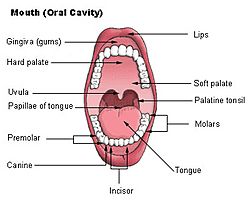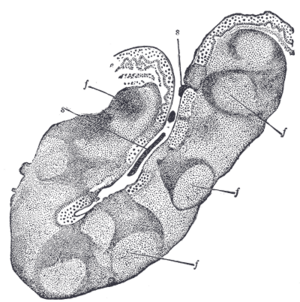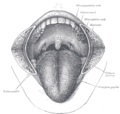Palatine tonsil facts for kids
Quick facts for kids Palatine tonsil |
|
|---|---|
 |
|
| Mouth (oral cavity) | |
 |
|
| The Palatine tonsils with the soft palate, uvula, and tongue visible. | |
| Latin | tonsilla palatina |
| System | Immune system (Lymphatic system) |
| Artery | Tonsillar branch of the facial artery |
| Nerve | Tonsillary branches of lesser palatine nerves |
| Precursor | Pharyngeal arches |
Palatine tonsils, often just called the tonsils, are small, soft lumps located at the back of your throat. You can usually see them on both the left and right sides. They look pinkish or like the color of your flesh. If they look white, it usually means they are swollen or infected, sometimes with pus.
When your tonsils get inflamed, it's called Tonsillitis. This can make your throat sore and give you a fever. Sometimes, if tonsillitis keeps coming back, doctors might suggest a surgery called a tonsillectomy to remove them.
Contents
What are tonsils?
Your palatine tonsils are found in a specific spot at the back of your mouth. They sit between two arches of tissue in your soft palate, which is the soft part at the back of the roof of your mouth.
Tonsils are an important part of your body's immune system. Think of them as guards at the entrance to your breathing and digestive systems. They help protect your body from germs and other harmful things that try to get in through your mouth and nose. Because they are on the front lines, they can sometimes get infected themselves.
Your tonsils are part of a group of similar tissues called the Waldeyer's ring. This ring also includes your adenoids and other tonsils deeper in your throat. The surface of your tonsils is covered with a protective layer of cells. Inside, they are connected to the wall of your throat by a strong, fibrous layer.
How tonsils get blood and nerves
Your tonsils have their own supply of blood and nerves. Nerves help them send signals to your brain. For example, some nerves that go to your tonsils also help you feel things and taste at the back of your tongue. If tonsils are removed, these nerves can sometimes be affected.
Blood flows to your tonsils through several small arteries. This blood brings oxygen and nutrients. After the blood has delivered what's needed, it flows away through veins back towards your heart.
Tonsil pockets

Your palatine tonsils have about 15 small pockets or folds called crypts. These crypts create a large inner surface area. Inside the tonsils, there are different areas where immune cells work. These cells help your body fight off infections. The very first part of your tonsils that germs meet is the outer layer of cells.
How tonsils work
Fighting germs
Tonsils contain special immune cells called B cells. These B cells can make different types of antibodies. Antibodies are like tiny soldiers that find and destroy germs. For example, tonsil B cells can make antibodies against common germs like poliovirus and certain bacteria.
Your tonsils also have T cells, another type of immune cell. T cells help B cells and also directly attack infected cells. Studies have shown that tonsils are very good at responding to germs you encounter naturally, like the rubella virus.
Immune messages
Your tonsils also produce special proteins called Cytokines. These proteins act like messengers in your immune system. They tell other cells what to do, like grow, divide, or move to where they are needed. Cytokines are important for controlling how your body responds to infections or other problems.
Scientists study cytokines in tonsils to understand why some people get tonsil problems more often. Both types of immune cells, Th1 and Th2 cells, are involved in tonsil conditions like swelling or repeated infections. Even when you feel healthy, your tonsils might still hold onto tiny bits of germs. This helps your immune system stay ready to fight.
Tonsil problems
Tonsils are often the site of infections, especially in children. This is because they are always dealing with germs and other things that enter your body. While we don't have one single reason why tonsils get infected, it's likely a mix of things. Viruses and bacteria can play a role, along with your body's own defenses and even things like your environment or diet.
Removing tonsils (tonsillectomy) is a common surgery for children. Doctors sometimes debate whether it's best to remove tonsils that get infected often. They weigh the benefits of getting rid of a problem area against the possible harm of removing an important part of the immune system.
To make the best decisions, doctors need to understand how healthy tonsils work and how they change when they become diseased.
Acute tonsillitis
Acute tonsillitis means your tonsils are suddenly inflamed. This is the most common tonsil problem. It causes a sore throat, fever, and makes it hard to swallow. Your tonsils might look red and swollen. Sometimes, you can see white spots or pus on them. Not everyone has all these symptoms.
Tonsils that keep getting infected
If you get acute tonsillitis many times, it's called recurrent tonsillitis. This usually means having several episodes of tonsillitis within a year or over a few years.
Enlarged tonsils
Tonsillar hypertrophy means your tonsils are enlarged, but they aren't necessarily infected. This is now the most common reason for tonsillectomy. When tonsils are too big, they can block your airway while you sleep. This can lead to loud snoring, irregular breathing, or even sleep apnea, where you stop breathing for short periods. It can also make it hard to swallow or make you feel sleepy during the day. These issues can sometimes affect a child's behavior or mood.
Images for kids
See also
 In Spanish: Amígdala palatina para niños
In Spanish: Amígdala palatina para niños




